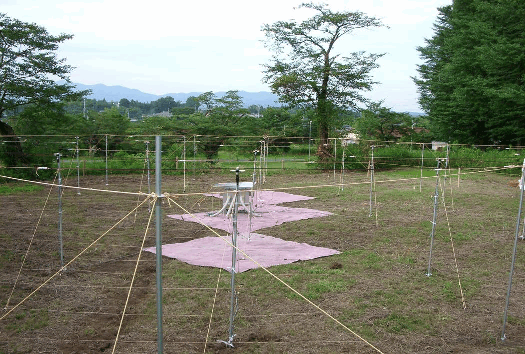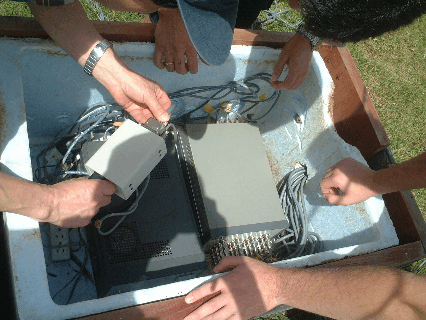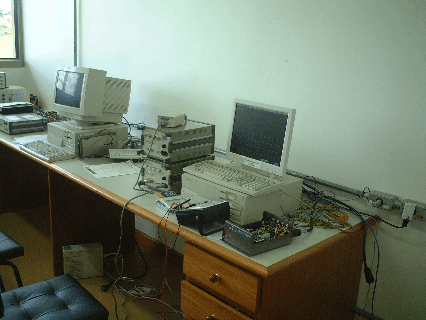An imaging riometer for ionospheric study (IRIS) which is capable of measuring shape, spatial scale and motion of ionospheric absorption was first developed at South Pole Station in the Antarctica in order to study dynamics of auroral particle precipitation in the high-latitude region (Detrick and Rosenberg, 1990). We installed the IRIS at Ny Ålesund (75˚ geomagnetic latitude) in Svalbard in the arctic region in order to study auroral particle precipitation around polar cusp region (Nishino et al., 1993). These IRISs consist of an 8x8 two-dimensional linear array with half-wavelength dipoles at 30 MHz frequency band.
The IRIS in South America was first installed at the INPE-SSO near Santa Maria in south-west part of Brazil, which consists of a 4 x 4 two-dimensional linear array with half-wavelength dipoles at the operating frequency of 38.2 MHz. The two-dimensional array is aligned in the geographic north-south (N-S) and east-west (E-W) directions, respectively, although the direction of each dipole inclines by 45º for the N-S and E-W directions (Fig. 1). By connection of the dipole array with a Butler-matrix phasing circuit and 4-channel radio receivers (Fig. 2), 4 x 4 two-dimensional beams with a half-power beam-width of 22º are directed upward to the ionospheric area centered at the zenith. The field-of-view (FOV) of the IRIS at the 100 km ionospheric altitude is approximately 330 km in the N-S and E-W cross-sections near the zenith.
Fig.1. Antennas

Fig.2. Butler Matrix and Receivers

Recording of cosmic radio noise data of 4 x 4 channels using a personal computer (PC) is basically the same performance with the Ny Ålesund IRIS system, (Nishino et al., 1992, Sato et al., 1992). Fig. 3 shows the recording system installed at the INPE-SSO (SMR station). Data analyzing system is commonly used with the Ny Alesund PC system. Data format on 4x4 channels is shown below the figures. First, original 4x4 data are converted to the 8 x 8 ones by the use of interpolation and extrapolation calculations. Next, background quiet day curves (QDCs) are reduced to obtain real ionospheric absorption from original cosmic radio noise data. About 10-days cosmic noise data on quiet ionospheric conditions are carefully selected from all data during one month. Then QDC values are calculated in a certain time-period by inflection point method (IPM) from the cosmic noise intensity distribution, and QDC curves are determined by running average of the QDC values. Thus absorption intensities are obtained by subtractions between original cosmic radio noise intensities and the QDCs.
Fig.3. PC for Operation

Antenna
